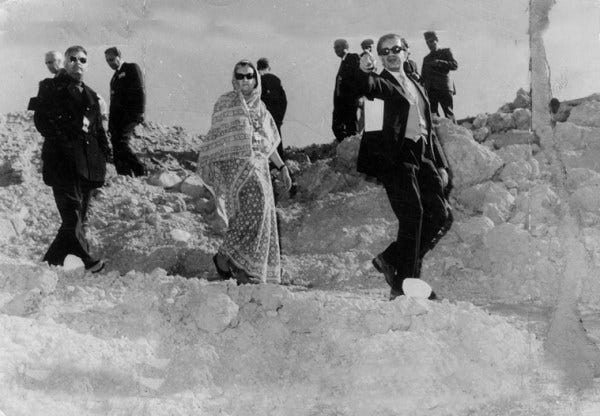Smiling Buddha's Golden Jubilee: The Genesis of India's Nuclear Capability in 1974
Looking back at the "explosive" event exactly 50 years ago that catapulted India into the ranks of nuclear powers.
Golden Jubilee of the Pokhran N-Test
India's first nuclear bomb test, code-named "Smiling Buddha," was a significant milestone in the country's history. Conducted on 18 May 1974, at the Pokhran Test Range in Rajasthan, this test marked India's entry into the exclusive club of nuclear-armed states. As we proudly celebrate the golden jubilee of this landmark event, today, on 18 May 2024, it's fitting to reflect on the events leading up to the test, the test itself, and its aftermath:
Events Leading Up to the Test
Historical Context:
Post-Independence Security Concerns: Post-1947, India faced security challenges, particularly from neighbouring countries like Pakistan and China. The 1962 Sino-Indian War and the 1965 and 1971 wars with Pakistan underscored the need for a robust defence strategy.
Nehru's Vision: Prime Minister Jawaharlal Nehru, though a proponent of nuclear disarmament, supported the development of nuclear technology for peaceful purposes. India's Atomic Energy Commission (AEC) was established in 1948, with Homi J. Bhabha playing a pivotal role in laying the groundwork for India's nuclear programme.
Development of Nuclear Capabilities:
Atomic Energy Act (1948): This act provided a framework for the peaceful use of nuclear energy.
Establishment of Key Institutions: The Bhabha Atomic Research Centre (BARC) was established in Trombay, Mumbai, to conduct nuclear research.
Foreign Collaborations: India benefited from collaborations with countries like Canada and the USA under the Atoms for Peace program, which provided nuclear reactors and technology.
Shift Towards Weaponisation:
China's Nuclear Test (1964): China's successful test heightened India's security concerns, prompting a strategic rethink.
Indira Gandhi's Leadership: Under Prime Minister Indira Gandhi's leadership, India accelerated its nuclear programme. The decision to conduct a nuclear test was taken secretly to avoid international scrutiny and pressure.
The Test
Preparation:
Secrecy: The test preparations were conducted under utmost secrecy to avoid detection by international intelligence agencies. The project was code-named "Smiling Buddha," reflecting its intended peaceful nature.
Role of Key Scientists: Dr. Raja Ramanna, Dr. Homi Sethna, and Dr. P.K. Iyengar were among the leading scientists involved in the design and execution of the test.
Logistics: The Pokhran Test Range in the Thar Desert was chosen as the test site. Extensive preparations were made to ensure the safety and success of the test.
The Test Event:
Detonation: On 18 May 1974, at 8:05 a.m., India successfully detonated its first nuclear device. The yield was estimated to be around 8-12 kilotons.
Immediate Reactions: The Indian government declared the test a success, emphasizing its peaceful intentions. The test was described as a "peaceful nuclear explosion" (PNE).
Aftermath
Domestic Reactions:
National Pride: The successful test was a source of immense national pride and was seen as a testament to India's scientific and technological capabilities.
Political Reactions: While the test garnered widespread support, some political leaders and parties raised concerns about the potential arms race and international repercussions.
International Reactions:
Mixed Responses: The international community had mixed reactions. Some countries, particularly Western nations, expressed concern and disappointment. Canada, which had supplied the CIRUS reactor, was particularly critical.
Sanctions and Diplomatic Pressure: India faced sanctions and diplomatic pressure, particularly from the United States and Canada. However, India managed to navigate these challenges and continued its nuclear programme.
Long-Term Impact:
Nuclear Doctrine: The test laid the foundation for India's nuclear doctrine and subsequent tests. India conducted a series of tests in 1998 (Operation Shakti), reaffirming its status as a nuclear-armed state.
Strategic Autonomy: The test underscored India's commitment to strategic autonomy and self-reliance in defence capabilities.
Non-Proliferation Debate: India's nuclear test reignited the global debate on nuclear non-proliferation. India consistently maintained its position on the discriminatory nature of the Nuclear Non-Proliferation Treaty (NPT) and advocated for comprehensive global disarmament.
Conclusion
The "Smiling Buddha" test was a watershed moment in India's history, symbolising its scientific prowess and strategic resolve. Despite international criticism and sanctions, India persevered in its quest for nuclear capability, driven by the need for security and strategic autonomy. As we celebrate the golden jubilee of this historic event, the nation proudly reflects on how the legacy of the 1974 test continues to shape India's nuclear policy and its approach to global non-proliferation efforts.





